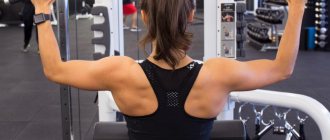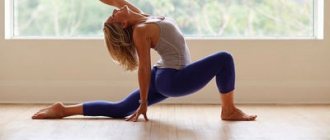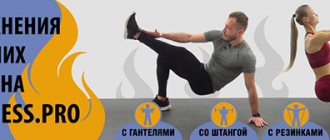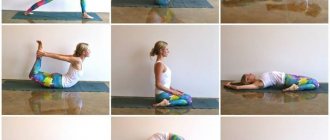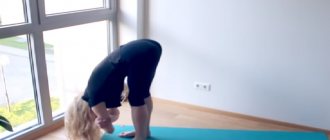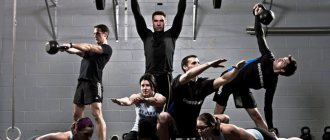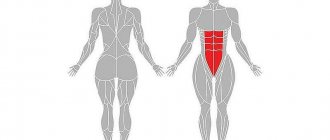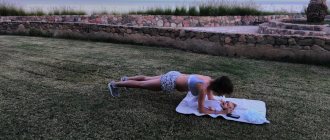Static exercises (isometric)
- these are exercises in which, during execution, the muscles do not contract, that is, the muscle tenses, but there is no movement. From a mechanical standpoint, work is not being done. When performing static exercises, your muscles hold the body or a specific joint in a stationary position. A striking example of a static exercise that was reviewed on our website is. The essence of this exercise is to keep the body motionless for a certain period of time, for example 1 minute. It perfectly works not only your abs, but also many other muscle groups. It’s not for nothing that it was included in the list of the most.
Static exercises should not scare you, because they are as natural as dynamic ones. Dynamic exercises are exercises in which your muscles are contracted (activated) and your body is allowed to move. A striking example is:, etc. Static and dynamic work involves keeping your body motionless (back muscles). When you perform barbell curls, the static work is performed by the deltoids, as well as the back muscles. Examples can be given endlessly, but my task is to convey this material to you in an accessible form so that the meaning itself is clear.
They take on most of the work, or as they are called slow ones, if the work is done at half strength or less. They are called red because they contain more myoglobin compared to white ones; it is myoglobin that gives them a redder tint.
If, however, a static exercise is performed with a large expenditure of energy or even to the maximum, the work begins. If the static tension is high, then the exercise develops strength and increases muscle volume, slightly yielding to the usual dynamics. With increased static load, the capillaries in the muscle fibers are pinched, accordingly the blood flow stops, and oxygen and glucose are no longer supplied to the muscles. All together leads to an increase in the load on the heart and the entire circulatory system, which has a negative impact.
It is impossible not to notice a feature in which muscles that are constantly exposed to static loads noticeably reduce their flexibility.
Of course, one cannot fail to note such a big advantage of static exercises as the fact that they can be performed practically anywhere, in any conditions. They do not require you to carry any additional equipment with you. Of course, if you perform static loads in a well-equipped gym, you can increase the effectiveness of the implementation by adding additional equipment.
Without condition, before each workout you should definitely do a good one.
To develop slow-twitch (red) muscle fibers, the exercise should be performed without the additional use of weights. Sets of exercises with yoga or may be perfect.
How to perform the exercise: you should take the desired body position and remain in this position until a burning sensation begins to appear, after which you need to wait 5-10 seconds and complete the exercise. A single exercise can be performed in several approaches.
As stated in the article, to engage red muscle fibers, the exercise must be performed at half strength or less.
If you want to engage white muscle fibers, you should perform the load with maximum force, using some external means (use additional weight), etc., which will make the exercise more difficult.
After performing sets of static exercises, you should do additional warm-up and stretching. You can also include some breathing exercises.
Conclusions:
Based on all of the above, we can draw the following conclusions and recommendations:
1. If you have problems with the cardiovascular system, heart problems, or any contraindications, you should not perform static exercises with high voltage.
2. Accordingly, in the absence of problems or any contraindications, increased load can be used to increase muscle volume and strength.
3. To effectively burn excess fat tissue, static exercises should be added to the training process (they need to be performed at half strength).
4. If you decide to supplement your workout with static loads, you need to pay special attention to warming up and stretching before performing.
5. Isometric (static) exercises can be performed daily, because after them, you don’t feel particularly tired the next day. Of course, you should also not abuse such loads. Everything should be in moderation.
6. Despite all the positive aspects of static loads, they cannot fully replace dynamic exercises.
7. Static exercises to develop strength should be performed with maximum load.
The next article will list the best static exercises, subscribe so you don't miss it!;)
Not much video motivation for your workouts:
4 shares
Anyone can perform static exercises. Bend your elbow and feel your biceps tighten. Hold for 30 seconds. So you have done your first static exercise in your life.
This type of training has many advantages, including the possibility of high-quality rehabilitation after injuries with its help and maintaining shape. In addition, “statics” may become the only training option for a person who does not want to go to the gym or purchase any equipment. But, like any particular method in physical education, it cannot be the only type of physical activity.
What are the advantages of static exercises
The main benefit is that static contractions can maintain muscle mass during periods of forced inactivity. Static exercises for developing strength are used for:
- active rehabilitation after injuries to joints and ligaments. During the period when the inflammation has stopped and the person returns to training, he can exercise on non-injured parts of the body, using classical exercises and maintain static shape where movements in the joints are excluded;
- “punching” some weak point in complex multi-joint exercises. In this case, a pause is used in the part of the movement from which problems begin. For example, if an athlete begins to “fold” towards the hips in the middle part of the squat amplitude, he should stop at this point and spend 8 to 12 seconds there, and then continue the movement;
- increasing strength indicators when the problem with them is the lack of stability during the exercise. This is a narrow technique used in powerlifting. Here a number of static exercises can be used to fix, for example, the correct position of the upper back in a squat.
In the training of amateurs with statics, outright chaos reigns. Some sources claim that, for example, callanetics, helps to get all the bonuses of strength exercises, including increasing muscle tissue density and accelerating metabolism, but without performing strength exercises. They often tell us that if a person does not want to “pump up muscles”, but strives for the slender figure of a ballerina, static is his everything.
Others point out the obvious benefits of statics for weight loss:
- people with a lot of weight already experience overload in their joints; if you replace regular exercises with weights with static ones, you can avoid pain in the knees and hip joints and reduce the load on the spine;
- those who are embarrassed to go to the gym can train at home and maintain the regularity necessary for losing weight without unnecessary stress;
- statics teaches you to feel muscle work. After a “course” of the same callanetics, learning basic power movements is much easier, and the safety of such practice will be at its best;
- statics allows you to not increase muscle volume too much, which is a plus for those who are afraid of becoming “big” but not slim.
Important: static gymnastics, for example, callanetics, are not a panacea for excess weight. In terms of fat burning (increasing calorie expenditure), they are inferior to even the simplest strength training, so they must be supplemented either with a fairly strict diet or with other types of training. The optimal combination is a cardio load of up to 200 minutes per week and three to four static one-hour workouts in a weekly physical activity plan. Including cardio is also advisable for the reason that static strength exercises do not train the cardiovascular system in any way and do not help increase calorie consumption.
Secrets for losing weight on your legs
Slender legs are undoubtedly the dream of any girl or woman. And if at a young age this problem is not so acute, then after 25 or later, in some people, cellulite begins to catch the eye, protruding “ears” on the hips or legs in general cease to please with their slimness, and more and more often they have to be hidden behind long skirt.
However, the advantage is that you pay attention to this at the very beginning of the problem, and not when you don’t know what to do. There is always a way out and a way to correct your figure, if only you have the desire and perseverance, the rest is a matter of time. Yes, it is persistence and determination that many women lack in the fight for extra pounds in their legs or in their bodies in general. The fact is that optimism quickly begins to be lost, excuses are found, but the result and visible effect were so close! This is about motivation and the final decision to lose weight in your legs at all costs.
Now let's look at the ways that exist for this. Everyone knows that by limiting your calorie intake, you can lose weight and change your appearance. This applies to the whole body, and legs in particular. Diet is always like salvation and the fastest way to achieve the desired effect. However, a diet is a diet, but do not forget that the body loses weight and after this sagging appears when skin tone is lost. This is why, in parallel with the diet, you should always do leg exercises. Thus, the muscles and skin will tighten along with the decreasing centimeters. Well, the second effect of leg exercises is an increase in the results of the diet. First, let's look at the issue of proper nutrition in order to achieve rapid weight loss in your legs.
Working out various muscle groups and fibers using static exercises
Static exercises primarily use slow-twitch muscle fibers. People who are naturally more resilient have more fibers of this type and tolerate static loads more easily. For this reason, naturally stronger athletes, whose bodies work better for 1-2 repetitions with maximum weight, should include statics in their training.
With the help of static exercises we can work absolutely all muscle groups. What is important is that such “hard-to-reach” areas, such as the transverse abdominal muscle, are also perfectly used in statics.
How to create an exercise plan for yourself?
- If you're working out to lose weight, it makes sense to work your entire body every workout. It would be preferable if a person first performed movements dynamically, and at the end of the workout worked the same muscle groups in a static mode. But an option is also possible when only statics and cardio are done, and the diet is followed.
- Optimally, about 36 hours should pass between training sessions with static exercises so that the muscles can fully recover. The rule that applies to static exercises is that you should not train the same muscle group day after day.
Chair workout
This short complex can be done while working to cheer up a little, stretch the body and load the muscles. Set a timer and do each exercise for a minute.
“Cat-cow” on a chair
Photo: Yulia Obolenskaya
This exercise will stretch your tired shoulders and back. Transfer your body weight to your sit bones, bend your knees at a right angle and press your feet to the floor. Place your hands on your knees.
Round your back and tuck your chin to your chest. Then squeeze your shoulder blades together, arch your back and stretch your neck. Try to arch more in the thoracic region - imagine that someone is pressing on your back in the area of the shoulder blades. Alternate the deflections, staying in each for 1-2 seconds, until the working time is over.
"Lumberjack" sitting
The exercise will slightly increase the mobility of the spine and strengthen the oblique abdominal muscles. Sit upright, straighten your back and press your feet to the floor. Place your palms together, turn your body to the right and raise your straight arms to the right and up. Then move your arms to the left and down, accompanying the movement by turning your body to the left.
Make sure that your pelvis does not lift off the chair during the exercise. Do 30 seconds each way.
Raising your legs on a chair
This way you can pump up your abs and hip flexors. Place your hands on the edge of the chair on either side of your pelvis and bend your knees. Lift your hips off the chair and back.
Squats on a chair
The exercise will load your thigh muscles and raise your heart rate slightly. Place your arms in front of your body, straighten your back, and press your feet to the floor. Keeping your back straight, rise from the chair until your pelvis is fully extended. Move your pelvis back and lower yourself back onto the chair. Make sure your back remains straight, help yourself with your arms by extending them to the sides of your body while lifting.
Pulling your knees to your chest
The exercise will strengthen the arm muscles, load the abs and hip flexors. Stand in a lying position with support on a chair, stretch your body in one line. Lift your legs one at a time, bringing your knees to your chest.
A set of exercises for all muscle groups
If the goal is to lose weight, you need to perform static exercises for 5-6 repetitions.
You need to start by holding each static pose for 30 seconds. Then continue, increasing the approach time to 90 seconds. When 90 seconds becomes easy to do, you need to change the set of exercises or add strength “classics” to your training. Between repetitions we rest for 30-60 seconds, the training pace should be relatively high.
Static exercises for legs
- "Chair" against the wall
Stand up straight, lean your back against the wall, step forward so that you can sit down comfortably, lower your pelvis below your knees and fix the squat, pushing your knees to the sides and resting your heels on the floor. Your knees should be pointing towards your toes. It is in this position that the muscles of the buttocks are better worked out. Once the time is up, straighten up, shake your legs and repeat again.
- "Bridge" lying down
You need to lie on the floor, heels to the buttocks, and push the pelvis up, as if “squeezing” the buttocks on both sides, one towards the other. The muscles should tremble already at the beginning of the approach. The body itself should be on the floor on the feet and shoulder blades; during the fixation time, it is necessary to firmly squeeze the buttocks.
- Keeping your legs suspended
You need to lie face down on a bed or sofa and grab a support with your hands. Next, we “hang” our legs in the plane of our back, strain our buttocks and the back of our thighs, and “stand” like this for the entire allotted time.
- Holding bent legs while sitting
We sit on the edge of the bed or sofa, place our legs as usual, bent at the knees. We tense the abs and the front surface of the thighs, lift the feet off the floor and hold them in weight by contracting the muscles.
Static abdominal exercises
- Classic forearm plank
Stand on your forearms and toes, pull in your stomach, tighten the front of your thigh and literally push your navel inward to remove the natural deflection in the lumbar spine. Hold the pose for the entire allotted time, try not to “protrude” your shoulder blades back and not bring your shoulders to your ears.
- Plank on one forearm (t-pose)
From the classic plank, transfer your body weight to your right forearm and toes, and get into the T-pose. Do an equal number of holds on both sides.
- Static twisting
Lie on your back, pull in your stomach, bring your lower ribs to your pelvic bones. Strongly contract your abs, try to “push” the abdominal wall inward with each repetition.
- Double static twist
Place your feet on the floor near your buttocks, first twist as in the previous exercise, leaving your hands behind your head. Then tighten your stomach and bring your legs to your chest, strongly “squeezing” the rectus abdominis muscle.
- Lateral twist
From a lying position, lift your right leg perpendicular to the floor, reach for your right leg with your left hand, and tense your abs strongly. Repeat on the other side, making sure that the number of repetitions is equal.
Back, chest and arms
- Static push-up
Stand in a plank position on your palms and toes, lower yourself with your back straight until your chest touches the floor, and fix this pose. The exercise is difficult; you can rest your palms on a bed, sofa or wall if the floor doesn’t work.
- Static triceps push-up
Everything is exactly the same, only the palms are placed ribs-width apart and the elbows are pointed straight back and up.
- "Superman" for back muscles
Lie on the floor on your stomach, lift your legs, arms extended forward and chest off the floor, fix the position, trying to pull your shoulder blades towards each other and, as it were, push them towards the pelvis.
Tadasana
Tadasana or mountain pose is the simplest pose to begin learning asanas. To build a pose correctly, you need to stand straight and connect your legs together, touching your feet. Spread your toes wide to give your feet more contact with the floor, while placing your weight on the center of your foot.
After this, tense your legs, it is especially important to tense and tighten your knees. Stretch your spine and straighten your neck, while tightening your stomach. Place your hands at your sides and hold the asana for at least a minute or more, watching your breathing.
This asana will help with arthritis in the cervical spine, elbow and shoulder joints, and with poor blood circulation in the lower extremities. This pose is harmful for people with migraines, low blood pressure and osteoarthritis of the knee joints.
Vrikshasana most often appears in standing yoga photos. It is indicated for use to correct pronounced flat feet and get rid of stoop. Contraindications for performing it are injuries to the calves, thighs and leg joints; it is forbidden to perform the asana even with high blood pressure.
To perform this pose, you need to take the Tadasana asana, raising your arms high and stretch your whole body upward, while your feet should not leave the ground and stand firmly on the ground.
Yoga nidra: technique of immersion in trance. 70 photos of people in a state of conscious sleepYoga for weight loss - the best exercises, basic techniques and intensity of exercise (95 photos)
- Pranayama - 50 photos, basic breathing techniques and tips in the initial stages
Bend your right leg strongly at the knee and place your foot on the inside of the middle of your left thigh. Place your heel near your perineum with your toes pointing down, then move your knee to the side. The pose must be held for several seconds.
To make it much easier to find balance, simply press your foot harder against your thigh and make sure that your hips are in the same plane and your hip joint is open while standing. The pelvis should not move to the sides, and the foot of the supporting leg should not be compressed.
This exercise is useful for correcting flat feet and poor posture. It is forbidden to use this pose if you have injuries to the hips, calves, bones and joints of the legs. Also, the pose is not suitable for people suffering from high blood pressure.
Contraindications and harm
Statics should not be practiced during an exacerbation of hypertension. Static and isometric leg exercises are not recommended for some types of varicose veins, and you should not exercise if you have a fever for any reason, including exacerbation of chronic diseases.
Damage from static can manifest itself in cramps if the person is generally overtrained or if their electrolyte balance is imbalanced. You need to monitor your fluid intake and not use any diuretics, especially for those who are losing weight.
It is also worth noting that the effect of the same callanetics on weight loss is exaggerated. Often girls give up on her classes before they begin to bring at least some effect, simply because they are waiting for the notorious weight loss of 3 sizes in 10 workouts. For static gymnastics to give just such results, a person must be significantly detrained and follow a fairly strict diet.
In general, static loads are a great addition to any weight loss program that is not yet based on basic strength exercises in a low-repetition mode. But static exercises are not the only form of physical activity. Do gymnastics for 6-8 weeks, and then, to avoid adaptation and stopping the weight loss process, move on to classic strength exercises with weights.
The article was prepared by Anna Tarskaya (trainer, nutritionist)
Static training (also called isometric) has been known since ancient times. They are used in martial arts, yoga, and serve to feel your own body, improve coordination, develop the strength of tendons and ligaments, without resorting to heavy loads and grueling training.
What is static load
You can tighten your muscles, pump up your abs, and correct your posture not only with the help of moving and active exercises. Static load is the same effective way to correct your figure as working on horizontal bars, exercise machines, pull-ups, squats, push-ups and other elements of sports training. It consists of lifting and holding a projectile or the weight of your own body motionless for the maximum period of time. Statics requires the same regular exercise, warm-up and stretching as any workout.
The benefits of static exercises
Those who seek to increase their strength and endurance will benefit from static exercises. In this sense, they are much more effective than dynamic ones. The advantage is achieved due to the fact that during constant tension, the blood supply deteriorates significantly, preventing lactic acid from reaching the muscles. The lack of this substance leads to the onset of muscle failure, that is, the inability to perform more than one repetition. The longer failure occurs, the stronger the muscles become.
All tension during statics is directed to the ligaments, tendons, and joints. The weight that acts on them trains their strength, reduces the likelihood of all kinds of injuries, including during dynamic training. If you use only your own body weight as a load in exercises (as happens in yoga), then such a load will never cause harm.
Isometric exercises at home are very useful for people who have previously suffered injuries and are unable to perform dynamic exercises. It affects the deep muscles, forces the maximum number of fibers to work, training and restoring them. This requires serious training, well-developed approaches, lasting 50–60 seconds.
Static exercises for weight loss
Any sport helps you lose weight, but not everyone can afford active training for health reasons. So, static exercises for women will allow you not to exhaust yourself with excessive loads in the gym. They are suitable if there are contraindications such as cardio exercise, diseases of the musculoskeletal system, or severe condition after surgery. This type of exercise leaves the pulse normal, no active movements are performed, but the fat folds disappear and the body tone increases.
To remove excess weight, static gymnastics for weight loss must be combined with proper nutrition. It is best to perform the complexes every other day, then the muscles will have time to recover and fat burning will occur evenly. The load should be increased gradually. Approaches last from 1 to 3 minutes, the number of repetitions is 2 – 3 times. The most effective static exercises for weight loss include the following:
- Plank. It uses all muscle groups. It is necessary to take an emphasis while lying on your arms outstretched or bent at the elbows and freeze.
- The side plank tightens your sides and abs. We take the emphasis lying on our side, leaning on our arm bent at the elbow.
- The boat allows you to tighten your back and abs. We lie down with our stomach down, arms along the body, raise our legs and chest at the same time.
Static exercises to develop strength
Body strength can be developed not only through sports such as various types of wrestling. Static exercises for developing strength begin to be mentioned in ancient Eastern techniques, as capable of bringing incredible power to the body without building muscle mass. To begin with, you can choose one of the simple complexes that does not require any equipment. These are popular isometric exercises for developing strength, developed by Alexander Zass.
The exercises of Zass, the famous circus performer and strongman, are known for their incredible effectiveness. The man himself demonstrated it, lifting the horse in front of the audience and effortlessly carrying it around the arena. He was sure that muscle volume is nothing compared to their strength, which can be developed without increasing muscle mass. To begin with, each technique can be performed 2-3 times, lasting 5-6 seconds.
- Bend your elbows near your chest. Palm rests on palm. We press our hands on each other.
- The hands take the same position, but are clasped. We try to disengage the lock by stretching our arms to the sides.
- We put our hands on the wall, push it with all our might, straining our whole body.
- We stand in the doorway, rest our hands on it and try to “push it apart”. All effort is concentrated in the shoulders and arms.
Static abdominal exercises
Millions of people dream of getting their belly in shape by doing hundreds of approaches of lifting/lowering their torso. But there are much more effective static abdominal exercises that literally burn fat at the waist and form a beautiful, flat, pumped up stomach. When performing exercises without movement, the load is enormous. It causes a burning sensation, but is compensated by excellent results.
The most effective static muscle work is achieved using the following exercise. We lie on our backs, hands behind our heads, raise our legs 20-30 cm from the floor, and freeze. At first, the strength will only last for a few seconds. You should try to increase the execution each time by at least 1 second, bringing it to 1 minute. We focus the tension in the abdominal area, but not in the back.
Static exercises for legs
To effectively load the muscles of your legs, you don’t have to run kilometers. Static leg exercises provide excellent strength training. For example, one of the favorite activities of plie dancers. We spread our legs as wide as possible, lower our pelvis so that our knees bend at right angles to the floor. Your hips and buttocks should be in a straight line. We stand on our tiptoes to tense our muscles as much as possible and hold for 30 seconds. Then we lower our socks. Rest for 10 seconds and do 3 more repetitions.
Here are some more simple exercises that cause static muscle tension. They are performed for 15-20 seconds with a break of 10 seconds:
- Sit on a chair, rest your heels on your legs and press as hard as you can.
- From a standing position, stand on tiptoes, tense your muscles as much as possible.
- Stand on your heels (you can hold your hand on the wall for balance) and pull your toes up as hard as you can.
Lateral leg raises
The exercise, performed while standing, is suitable for both sexes. It is recommended to do it as a warm-up. But if you use weights, you can incorporate lateral leg raises into your lower extremity strength training. It will help to effectively pump up the thigh muscles.
Weights can also be used when performing the lateral leg raise exercise. However, this option is usually preferred by women. Men who train in the gym are rarely interested in exercises that will not build muscle mass.
If you work standing, the load is placed on the following structures:
- Thigh muscles;
- Abdominal muscles;
- Lower back muscles.
At the same time, the muscles do not increase in size, but simply become stronger and more resilient. That is why this exercise is recommended to be done regularly by people who run.
Raising your legs forward and backward from a standing position is also quite effective. Include them in your warm-up too and do them before each workout. Doing 15 to 20 repetitions of each movement is not difficult - it will take a couple of minutes.
But the muscles of the lower extremities will be sufficiently warmed up and will not suffer during the exercise. For girls, lateral leg lifts are useful in themselves, as they help tighten the “problem” area – the inner thighs. If you are not confident in your technique, check out the video of lateral leg raises.
Static exercises for the buttocks
The techniques we use to train our legs also have a positive effect on our buttocks. Among the static exercises for the buttocks, which have many positive reviews, are the following:
- Chair exercise. We rest our backs against the wall (feet about 30 cm from it) and slide down until we squat in the air at an angle of 90 degrees. We stand for 20 seconds. We do 5 approaches with a rest of 10 seconds.
- We lie on our stomach, raise our legs from the knees and below to a height of 20 cm. The back is straight, does not bend in the lower back.
- We lie on our backs, bend one leg at the knee, and the other is extended. Raise the pelvis and straightened leg at the same level. Hold for 5 seconds. Do 10 repetitions and change legs.
- We repeat the previous exercise, but the free leg is extended upward, not straight.
Exercises for slender legs: down with the elevator
You, of course, know: the best exercise for legs is a staircase. And the best exercise for beautiful and slender legs is climbing stairs (ascending, not descending!) The staircase not only trains muscles, but also miraculously relieves venous insufficiency - a real scourge of modern office beauties.
If your feet swell at the end of a day sitting at a desk and computer, skip the elevator and take the stairs more often.
We also recommend including this variation of climbing stairs in your set of exercises for slender legs.
Static exercises for the back
The health of the spine determines the condition of the entire body. Static exercises for the back will strengthen and improve your health. They are divided into 4 levels: for the lumbar, thoracic, shoulder, and neck muscles. The main condition is to perform them without jerking and slowly. This takes a lot of time, but if you don’t have it, do the simplest and most useful exercise at work, at home, standing in line or at the stove: starting position standing, one hand on your belt, take deep breaths, press with your palm on the place of support, the spine is We pull up with all our might.
Gymnastics for the cervical and lumbar spine
Exercises for the lower back
Hanging on the horizontal bar
Hang on the bar and breathe evenly. Slowly pull your bent legs up and stay in this position for 15-20 seconds. Gently straighten up and repeat leg curls 2-3 times.
Let your muscles rest for a few minutes between sets.
Curls while hanging
As in point 1, hang on the horizontal bar and slowly turn your pelvis alternately to the right and then to the left. Try not to strain your back.
Lie on the floor, place your arms along your body. Bend your knees and lift your pelvis up, resting on your feet. The arms and neck remain in place. Slowly lower your body down and repeat the exercise 10-15 times.
Circular movements of the hips
Standing on the floor, place your hands on your waist and begin circular movements with your pelvis, first to the right, then to the left. Repeat 5-10 times.
Neck exercises
Video: a set of static exercises
Anyone who wants to increase strength, but not add volume, cannot do without static exercises. When performing them, the muscles become very tense, but no movements are made. Depending on the strength of the exercise, red or white muscle fibers come into play. Each type performs a specific function: red ones help to obtain energy from subcutaneous fat reserves, and white ones promote muscle growth. If you want to use red fibers, then you need to do static exercises for the abs or any other part of the body half-heartedly. If it is important to get the white fibers to work, then perform the exercise at full strength.
A set of exercises for the spine that can be performed at home
It would seem that the problem is easily corrected: you just need to exercise more and eat vitamin supplements containing calcium more often. But experts say that this lifestyle does not prevent curvature and other diseases of the spine.
Until the curvature becomes pathological, special exercises for the back are very effective. At later stages of spinal diseases, they are less effective, but prevent the development of diseases and deterioration of human health.
A set of exercises for the spine can be performed at home as exercise in the morning or to relax the body after a hard day. As a rule, it takes no more than 5 minutes to complete one exercise, and no more than a quarter of an hour to complete the whole complex.
Spinal stretching exercises
One of the most effective sets of exercises for back health is spinal stretching . When the spine is stretched, the distance between the vertebrae increases, resulting in less pressure on the deformed discs and nerve. Periodic stretching can reduce back pain.
When performing exercises at home, you should not try too hard, move abruptly, or increase the amplitude as much as possible, especially if you do not know exactly what condition your spine is in.
Hanging on the horizontal bar
These are the simplest exercises for stretching the spine at home. It is better to perform them on a horizontal bar, the height of which exceeds your height, so that you do not have to bend your legs. While hanging on your hands, breathe evenly, do not hold your breath. There are no clear limits on how long you can hang; if you feel tired, drop to the ground and take a break. You should return to the horizontal bar only after a break.
Hanging on your legs upside down is performed in the same way, but is not recommended for people with poor physical fitness.
"Child's Pose"
Lie face down on the floor. Place your palms on the floor directly under your armpits and push up while pushing your knees. In the intermediate position you will be on all fours. Do not linger and lower your chest to the floor, while your arms straighten. The body forms a triangle with the highest point at the pelvis. Face the floor, do not bend your arms, just let them lie on the floor. Gently get out of this position as soon as you feel tired.
"Cat"
Get on all fours and arch your back as far as you can. Aim to touch your chin to your chest. After a few seconds, bend your back down, your face rises up. Alternate up and down curls 10-15 times.
Stretch marks on the floor
Sit on the floor and spread your legs as wide as possible. Slowly lower your body towards the floor as far as the stretch allows. Stay in this position for a while, and slowly rise up when you get tired or feel discomfort. Your back should be straight throughout the entire exercise.
Crunches
Starting position as in the previous exercise. Bend one leg slightly at the knee and turn your body towards it. The back remains straight. Place your hands on your knee or thigh, depending on how flexible you are. Switch legs and repeat the twist. Breathe freely. Perform 4-5 approaches.
Do the twisting while exhaling.
Static exercises and the hormonal system - how exercise affects the body
Performing this type of exercise forces the muscle fibers to tense only at one point, without moving with different amplitudes. Not only does severe muscle tension arise, but also psychological tension. As a result of this, the body's endocrine system begins to work actively, releasing hormones that cause a burning sensation with maximum muscle tension.
This training method has its own characteristics. During static exercises, blood pressure rises quite strongly. This occurs due to the fact that blood circulation in immobile muscles is impeded, which puts a lot of strain on the heart and blood vessels. Therefore, static exercises are not recommended for those people who have quite serious disturbances in the functioning of the heart and atherosclerosis.
In addition to poor blood circulation, it is also necessary to take into account the fact that joints and muscle fibers remain motionless. The muscles only increase in volume, but do not grow in length, which has a significant impact on the mobility and plasticity of body parts. Therefore, it is very important to do stretching after performing static exercises, provoking fiber growth in length.
Instead of static ones, you can give preference to static-dynamic exercises, which do not put so much strain on the cardiovascular system. The peculiarity of static-dynamic exercises is that you remain motionless for some time, and after that you begin to perform movements with a small amplitude until a burning sensation appears in the muscles.
Effective varieties of static exercises for legs and buttocks, abdominals and back
It is better to do static exercises for the legs, gluteal muscles, abs and back at home, since they will require a chair, a fitness mat and flat walls.
A set of exercises for the buttocks and leg muscles:
- standing near the wall, do a squat so that your back fits tightly against the wall, but does not lean on it. Your legs should be bent at the knees so that they form a right angle. You need to stay in this position for 30 seconds, then rise and let the muscles relax;
- For the gluteal muscles, you need to do exercises near a chair or table so as not to lose your balance. Grasping the back of the chair, lift your left leg back so that it forms a parallel line with the floor. Hold this position for half a minute, change legs and start all over again.
Complex for the abs and back:
- plank – you can lean on your palms or bend your elbows and lean on your forearm. Start holding for 30 seconds and gradually increase the time;
- corner - perform on the mat. Lying on the floor, begin to raise your straight legs and arms with your body until your body forms a right angle. Fix in this state for half a minute, then let the muscles relax and repeat;
- lying on the floor, bend your knees, arms along your body. Raise your pelvis so that your thighs and shins form a right angle. Hold the position for 30 seconds, then rest and repeat;
- get on all fours, raise your right leg and left arm. Having straightened them and raised your head, hold the position for 20 seconds, then switch arms and legs and repeat.
The number of repetitions of such exercises is set individually. It is recommended to perform them until a burning sensation occurs in the muscle fibers and it is no longer possible to do repetitions.
Exercises to straighten the spine
"Skydiver"
Starting position: lying on your stomach. Raise your arms and legs at the same time and hold them in this position for as long as you can.
If physical fitness does not allow, lift one limb at a time diagonally.
"Basketball basket"
Lying on your back, lift your knees up and clasp your arms. Pull them towards you, while at the same time reaching towards them with your head. Execution time – 15-20 seconds. Repeat 5-10 times.
Sit on the floor and lean on your arms out back. Bend your knees and rest on your feet. From this position, lift your body parallel to the floor 15-20 times. You shouldn’t lift slowly, but at the highest point, stop for a few seconds and start lowering your body. One approach.
